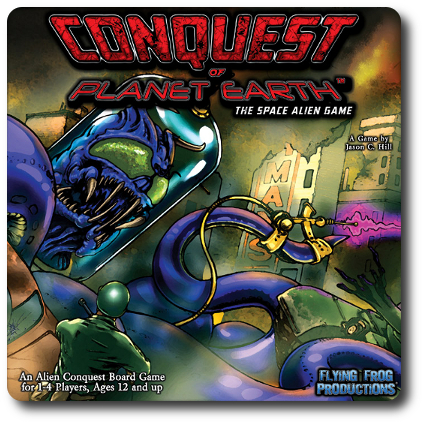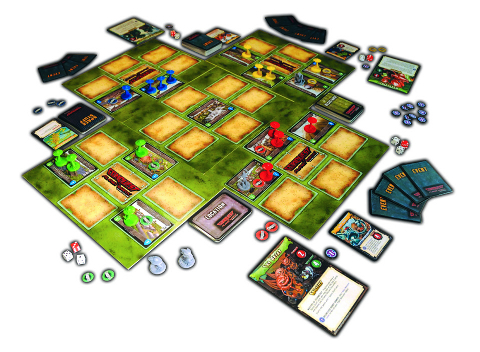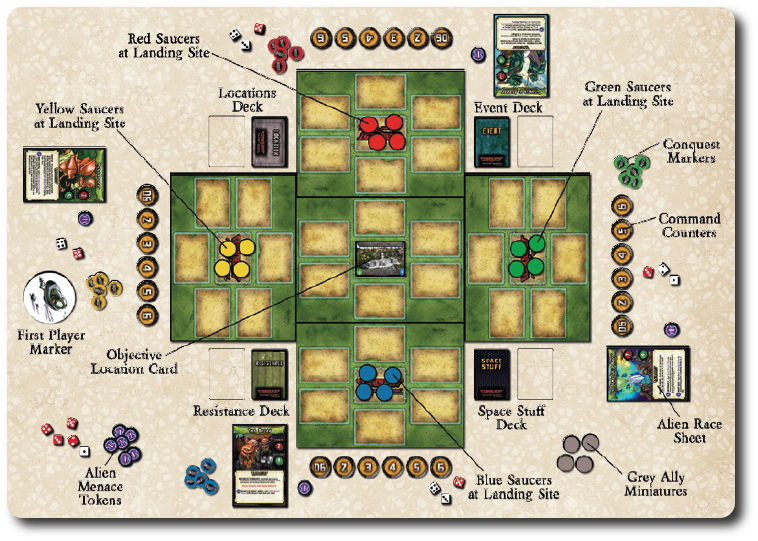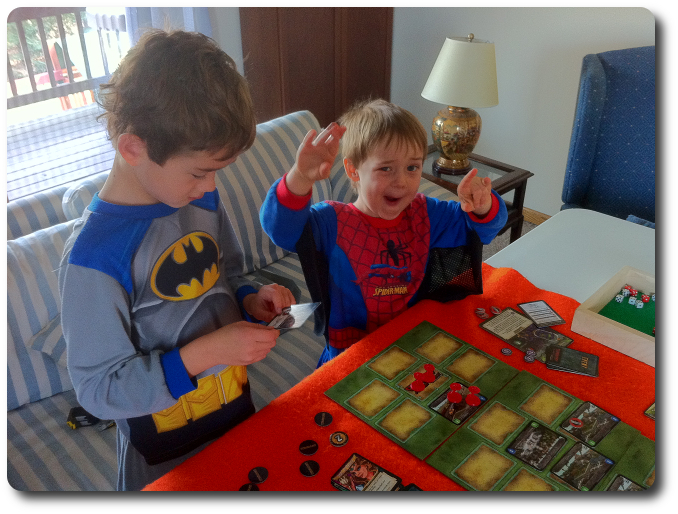
The Basics:
- For ages 8 and up (publisher suggests 12+)
- For 1 to 4 players
- Approximately 60 minutes to complete
Geek Skills:
- Active Listening & Communication
- Counting & Math
- Logical & Critical Decision Making
- Reading
- Strategy & Tactics
- Risk vs. Reward
- Cooperative & Team Play
- Hand/Resource Management
- Worker Placement & Area Control
Learning Curve:
- Child – Moderate
- Adult – Easy
Theme & Narrative:
- Grab your laser pistols and warm up your intergalactic flying saucers because it’s time to invade Earth!
Endorsements:
- Gamer Geek approved!
- Parent Geek approved!
- Child Geek approved!
Overview
Ah, summer time. Long days full of warmth and fun, and balmy nights to go star-gazing. Wait a minute…is that a falling star coming down? Looks like it, but it’s not falling right. Hold up! That falling star just stopped and is now flying across the sky! OH, MY GOSH! THERE’S ANOTHER ONE! GADS! IT JUST SHOT SOME SORT OF RAY OUT OF THE BOTTOM OF IT! THE COWS ARE BURNING! And it started out as such a lovely evening…
Conquest of Planet Earth: The Space Alien Game, by Flying Frog Productions, is comprised of 5 Game Board Sections, 20 plastic miniatures (4 green Player Saucers, 4 blue Player Saucers, 4 red Player Saucers, 4 yellow Player Saucers, and 4 grey Ally miniatures), 70 Event cards, 35 Resistance cards, 25 Space Stuff cards, 35 Location cards, 6 Human Tech cards, 1 Object Location card (double-sided), 10 Alien Race sheets, 1 Resistance Phase sheet, 4 player reference cards, 16 six-sided dice (8 in red, 8 in white), 1 game play soundtrack (CD), and lot of die-cut counters. Lots. As is typical of Flying Frog’s products, the component quality is fantastic. Thick boards and thick cards, colorful illustrations, and easy to read text. And the amount of gloss they put on the components has to be a new record.

Game Set Up
Note: There are four styles of play for Conquest of Planet Earth. These are competitive cooperative, team, and solo. The competitive style game set up is summarized here. Both the solo and the cooperative have slight changes to the set up, which are described in the rule book.
To set up the game for competitive play, first build the game play area by giving each player a Game Board Section. In total, you will be playing with one Game Board Section per player, plus one. For example, if you are playing with two players, you will use three Game Board Sections. They will then be put together as shown in the below image.

Second, take the double-sided Location Objective card and place it in the center space of the center Game Board Section. This is the primary objective of all players (note the Location Objective is double-sided and provides the players an opportunity to pick which rule for that location they want to use).
Third, separate the Event, Resistance, Space Stuff, Location, and Human Tech cards into their own decks. Give each deck a shuffle and put them face-down near one side of the game playing area.
Fourth, either shuffle the Alien Race sheets and have each player pick one at random or have the players pick their Alien Race. The Alien Race sheet is placed in front of the player. All remaining Alien Race sheets are removed for the duration of the game. Each player should then select which color they want to use and take all the Flying Saucers of that color, as well as the Conquest markers that are of the same color. Additionally, each player should take Command counters so they have one “2”, one “3”, one “4”, one “5” and one “D6”. These are placed face-down next to the player’s Alien Race sheet.
Fifth, in front of each player should be one Game Board Section. The middle portion of the section is the player’s landing site space. The player’s Flying Saucers are now placed on that space. This landing space is the property of the player and can only be used by them to bring in more aliens to conquer the pitiful humans.
Sixth, place all the tokens into separate piles near the game playing area. They will be retrieved when needed during the game. After putting all the tokens into piles, hand to each player one Alien Menace token. Place the dice to one side of the game playing area, too, while you are at it, along with anything else we did not specifically mention.
Seventh, each player now gets a number of Event cards equal to their alien race’s intelligence (noted on the Alien Race Sheet). For example, an intelligence of “5” means the player is dealt 5 Event cards. Players should look at their cards, but keep them hidden from their opponent’s at all times.

That’s it for game set up! Time to invade!
How to Invade
Note: Conquest of Planet Earth has a lot of rules. When you are first learning how to play the game, it can seem a bit overwhelming because the rule book goes into great detail. More words makes it seem that there is a lot to learn, but this is not the case. Conquest of Planet Earth is a fairly straight forward game with well-defined playing phases. It’s the many things you can do during those phases that give the game an air of difficulty. We will only summarize them here and encourage you to read the full rules for all the details…of which there are many.
The game is played in rounds, with each player being given a turn during the round. The very first part of every round involves all the players at once. After that, each player will take their own individual turn in clockwise order. A typical player’s turn is summarized here.
Step 0: The Command Phase
This is the very first thing all the players will do at the beginning of each round. Once it is done, this step is not visited again by any of the players until the next round.
During the Command Phase, each player will secretly select one of their Command counters. The number on the counter determines how many action points the player will have available to them for the entire round. Note that once the Command counter is used, it is no longer available to select until later in the game (the one exception is the “D6” that can always be used).
Once selected, the players put their Command counter in front of them, face-down. Then they are all revealed, with any player who selected the “D6” rolling a six-sided die to determine their number of action points for the round.
The player with the lowest number of action points showing becomes the first player for the round.
Step 1: The Action Phase
The first step on a player’s turn is the Action Phase. During this phase, the player will ready any activated cards and then spends their action points. Action points are spent to move aliens, bring in new aliens (reinforcements), gain an Alien Menace token, or pay for Event cards (that have various action point costs). Action points cannot be “banked” for later rounds, but the player is never forced to use all of them, either.
Step 2: The Battle Phase
The second step on the player’s turn is the Battle Phase. During this phase, the player explores new areas on the Game Board Sections, encounters human resistance, and if another alien race happens to be there, exchange some laser fire. In many ways, the humans are actually more of a threat than the other aliens as they have special abilities that can make a seemingly simply job of nuking an entire town into a difficult affair. Each location could have a small or large force that players will need to contend with. The problem (and party of the fun) is that the player won’t know what they are up against until they are surrounded by it.
Step 3: The Draw Phase
The third and last step on the player’s turn is the Draw Phase. Players may discard up to one unused Event card, but will always refill their hand so that the total number of cards is equal to their Alien’s intelligence value. Any cards that say “Play Immediately” once drawn should be played – well – immediately. Players do not get to draw another card to replaced these cards.
This completes the player’s turn. If it is the end of the round, a new round begins with Step 0. Otherwise, the next player going clockwise will now have their turn starting with Step 1.
A Quick Word On Combat
During the game, the players will be engaged in a lot of skirmishes. The time it takes for a player to destroy the resistance in a location is referred to as the “Battle”, but each battle is broken down into separate “Fights” where either side can get the upper hand, but not necessarily win the battle outright.
The Resistance value of a location determines how long each pocket of resistance will remain in that location for the overall battle. For example, a Resistance value of 1 means that the location will be won as the result of one fight. To resolve a fight, a Resistance card is drawn and placed face-up on the table. The card will either be labeled “Resistance” or “Hero”. Resistance has a strength value and represent the force in place trying to take the Alien Invaders down. A Hero is a lone individual who assists the resistance and provides a strength bonus.
Once the Resistance cards are drawn, the total strength is added together. The player’s strength is by default the Alien’s listed strength times how many Flying Saucers are present at that location.
The dice are then rolled, with an opponent rolling for the Resistance. A single six-sided die is rolled for each group (the player and the Resistance) and the value is added to the individual group’s strength total. Whichever side has the HIGHER strength total wins the Fight round. If either side ever rolls a “6”, the Fight immediately goes to that player as a “crushing victory”.
During combat, cards and abilities that affect combat can be used, until the total strength has been calculated after the dice rolls.
If the player wins the Fight round, the Resistance is defeated and discarded along with any Heroes who attempted to help, but obviously failed. The next fight then begins with another Resistance card being drawn. If the player wins a number of fights equal to the location’s Resistance value, they have won the battle and can move into the location, gaining a number of Terror Points equal to the location’s Population value. This is done by placing a Conquest marker on that location. As long as it remains, the player has that many Terror Points.
If the Resistance wins the fight, the player loses one of their Flying Saucers, which means their overall strength will be reduced for the next fight. When the last Flying Saucer is removed, the battle is over and the Aliens have lost. Of course, an Alien could always attempt to escape the battle by moving to a friendly location.
Winning the Invasion
The first player to collect 8 or more Terror Points immediately wins the game (if not canceled by a card played by an opponent). All the other Alien Races must hastily depart and never set a tentacle on the planet’s surface again.
We’ve only scratched the surface of this game! There is a lot more to the combat, the card play, and the many tokens we didn’t even bother to mention. We also didn’t cover the differences in the cooperative, team, and solo game. If what you’ve read so far interests you, visit the game’s web page to learn more and don’t forget to download the full rules for all the details.
Prediction
Jeepers, there’s a lot to read for this game. The rule book alone is 23 pages long and all the cards have additional text on them that describe what they do and how they should be used. This is not going to be a game I can sit down and learn in 15 or so minutes. Nor is this a game I want to try to teach players until I understand ever single corner of it. On a funny side note, I opened this game up at Gen Con 2012 while waiting in line to view the custom contest. I knew we were going to be in the line for a while (you get there early to get a good seat) and took out the game for us to play. After reading the rule book for about 20 minutes and punching out all the tokens, we decided that a waiting line was not the best venue for a game of this magnitude.
Teaching this game to the Gamer Geeks is going to be pretty easy. After I’ve learned how to play the game, all I’ll need to do is quickly go through a round and explain some of the more commonly used components to them. I can introduce new rules and explain the more detailed portions of the game right before a player needs to know or when they encounter them. This is how many of our more complicated games are taught to the Gamer Geeks and there has never been an issue.
For the Parent Geeks and Child Geeks, I’m going to have to really help them out. I think I’ll go with the cooperative style game at first and then introduce the competitive game when the players are more familiar with how it is played. I honestly don’t see how else to teach this game to players who often don’t have the time or the experience to easily learn a game that is this involved.
And involved it is. After reading the rules (3 times), it became very apparent that this was a game where messing with your neighbor and playing cards like crazy was all part of the fun. There is a lot of chaos in the game based on the randomness of the cards, the randomness of the action points, and the randomness of player decisions. That makes the game hard to pin down and streamline for teaching because anything can happen, and usually does.
And so, after making sure I knew exactly what I was doing, I sat down with my oldest little geek and we set the game up for a 2-player cooperative session. I made sure he had the time and was willing to play the game. The time part was easy (I’m his dad and more or less get to dictate his schedule), but the willingness took some work. The first step was to get him to look at all the cards and the rule book. My plan almost backfired on me after he saw the rule book, however, as he found it very intimidating. But I reminded him that he had learned how to play more complicated games. This helped him work through his anxiety and we set up the game on a Saturday morning. Before we played, I asked him his thoughts on the game so far.
“I really like how the cards look and the game bits are super cool. I need to play the game before I think it’s good or bad, however.” ~ Liam (age 8)
Good grief, I think we have a little game reviewer in the making here! Let’s play the game and see if it conquers my little geeks’ heart or blasts it into a billion little particles of “meh”.
Final Word
You’ll please note that this game was approved by all three of our groups. However, it is VERY important to point out that their level of approval is based on different styles of play. Flying Frog Productions decided, either through mystical glimpses into the future or just good old-fashioned reasoning, that providing four different styles of play for this game was a really good idea. Each style provides a different level of control and stability, as well as sharing the load of chaos that is going to be dumped on a player’s shoulders.
The Child Geeks rather liked the game, but only when they played it solo, cooperatively, or as team with a Parent Geek. None of our Child Geeks lasted through more than 3 rounds of a competitive game. They found the competitive game style play to be too complicated to keep track of and too chaotic to really enjoy. But when they could work through their moves with their Parent Geeks, they had a great time.
The same can be said for the Parent Geeks. The cooperative and team games were their favorite, as it allowed them to play the game with their Child Geek or with another Parent Geek. The solo play was not enjoyed much at a peer level with the Parent Geeks, but this style of play did serve as an excellent way for both the Parent and Child Geek to learn how to play the game together with only one alien to worry about.
The Gamer Geeks didn’t care for the solo, team, or cooperative game styles and stuck with the competitive. They greatly enjoyed how chaotic and frantic the game was and the many, many ways they could mess with each other. The level of chaos and “take that” was only something a true Gamer Geek could have enjoyed. And enjoy it they did.

A recent cooperative game, where my two oldest little geeks worked together with me to squash the humans!
Gamer Geeks, this game was approved by your peer group because of the level of strategy, tactics, and player interaction the game provides and requires. There is no player elimination, which means more times than not, many Gamer Geeks were taking riskier chances they probably would have done otherwise. This caused a great deal of over the top game play and raised the bar on smack talk around the table. The game is not perfect, however, and will drive any Gamer Geek bonkers who dislikes game mechanisms that demand chaos. The game can also over stay its welcome a bit, playing just a little too long at times. This is because players are never kicked from the game. Regardless, all the Gamer Geeks we played the game with found it to be silly fun.
Parent Geeks, this is a chaotic game but worth your time. Your peer group approved the game but only when it was played cooperatively or as a team game with the family or taking on a partner when playing it solo. The game is rather involved with the rules, but the game plays fairly quickly once you learn how. The biggest hurdle in this game will be the many cards and learning that, more times than not, it doesn’t matter which card you play. All that matters is that you play cards. The game rewards you if you play hard, don’t take anything seriously, and above all else, have no qualms about leveling a human city to the ground with a giant robot.
Child Geeks, this is not a game you’re going to be able to pick up and play at the table without some help. My 8-year-old could play the game, but only if I assisted him. Note that I said “assisted”. I didn’t play the game for him. With a Parent Geek or an older brother or sister who knows how to play more complicated games by your side, you are going to have a lot of fun trying to beat the game together. And that’s what really won the Child Geeks over; the amount of team play the game provided. Working together to crush the humans was found to be a lot of fun and excellent “family bonding time” as everyone works as a team to enslave the human race. Ah, memories…
Conquest of Planet Earth is no walk in the park. It’s not an easy game to beat, but it is a lot of fun to play. I wouldn’t recommend this game to just anyone, however, as this is very much a game that demands the player’s time and patience. All of our groups enjoyed the game, but for very different reasons. The one universal item they all agreed on was that the game was “crazy fun”. But “crazy fun” doesn’t mean it’s for everyone. The game is pure chaos at times and that might be enough to turn many away. As for me, I enjoy the occasional game where I don’t know which end is up, who my enemies are, or what I am going to do next until it matters.
So, if you are looking for a game that is “crazy fun”, where you get to play as an alien who can take a beating (and return it in spades), provides four different styles of play (essentially making it four games in one), then do abduct Conquest of Planet Earth as soon as possible.
This game was given to Father Geek as a review copy. Father Geek was not paid, bribed, wined, dined, or threatened in vain hopes of influencing this review. Such is the statuesque and legendary integrity of Father Geek.



